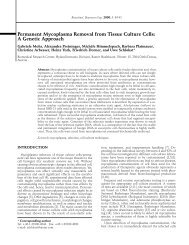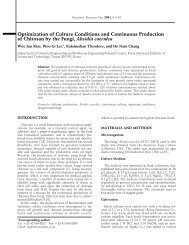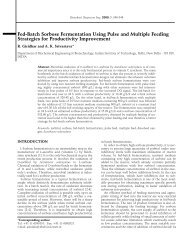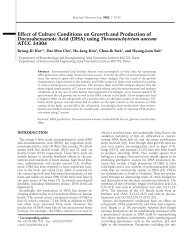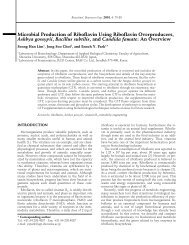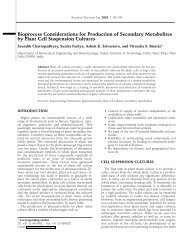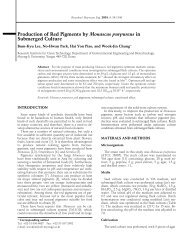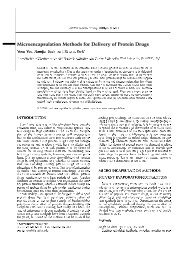Hydrolysis of Oils by Using Immobilized Lipase Enzyme: A Review
Hydrolysis of Oils by Using Immobilized Lipase Enzyme: A Review
Hydrolysis of Oils by Using Immobilized Lipase Enzyme: A Review
Create successful ePaper yourself
Turn your PDF publications into a flip-book with our unique Google optimized e-Paper software.
64 Biotechnol. Bioprocess Eng. 2002, Vol. 7, No. 2<br />
<br />
<strong>of</strong> internal diffusion, but they increase the magnitude Where, η is independent <strong>of</strong> S for the first-order reaction.<br />
<strong>of</strong> any pressure drop. Regular-shaped particles are much In packed bed reactor Equation (14) becomes<br />
better at reducing the problem <strong>of</strong> high-pressure drop in<br />
2<br />
packed beds and <strong>of</strong> irregular flow pattern, as observed V R ln[1 − x]<br />
= <br />
(21)<br />
<strong>by</strong> O’Neill et al. [27]. In general, the size <strong>of</strong> the particle, F ( 1− ε)<br />
De ϕ<br />
cothϕ1<br />
− 1]<br />
which shows essentially no internal diffusional limitations,<br />
is so small that the pressure drops incurred become<br />
prohibitive.<br />
Continuous Stirred Tank Reactors (CSTR’S)<br />
Based on the pseudo-steady state assumption the<br />
design equation for immobilized packed bed reactor can<br />
be expressed as follows:<br />
S<br />
V 1<br />
out<br />
dS<br />
= − ∫<br />
F 1−ε<br />
η − r<br />
S<br />
in<br />
( )<br />
s<br />
(14)<br />
The volumetric rate (-r s<br />
) can be separated into two<br />
terms for any enzymatic reaction whether it is onesubstrate<br />
irreversible or multi substrate reversible [18].<br />
(-r s<br />
) = Ef(S,P) (15)<br />
the simplest expression <strong>of</strong> f(S,P) is a hyperbolic function<br />
<strong>of</strong> S as typically shown <strong>by</strong> the Michaelis-Menten equation.<br />
The different CSTR configurations have been employed<br />
<strong>by</strong> a number investigators [2]. CSTR’S posses<br />
some particular advantages over fixed bed reactors, e.g.,<br />
lower construction costs and efficient stirring that<br />
eliminates the presence <strong>of</strong> concentration and/or temperature<br />
gradient. In general, however, a CSTR must be<br />
larger than a packed bed reactor to achieve the same<br />
extent <strong>of</strong> reaction. In order to prevent the immobilized<br />
lipase from leaving the CSTR, a micr<strong>of</strong>ilter or a screen<br />
must be provided at the reactor outlet.<br />
Based on the pseudo-steady state assumption the<br />
design equation for CSTR can be expressed as follows:<br />
V S<br />
x<br />
=<br />
F −<br />
ε)η( −r<br />
<br />
<br />
(22)<br />
f(S) = kS/K m<br />
+S (16)<br />
Equation (16) has two extremities: (i) first order kinetics,<br />
(-r s<br />
) = (kE/K m<br />
)S. where S > K m<br />
.<br />
X = (S in<br />
-S out<br />
)/S in<br />
(17)<br />
Equation (14) is modified into following forms, depending<br />
on the intra particle and film diffusion.<br />
(a) No limitation <strong>of</strong> diffusion (η=1.0): when the reaction<br />
rate <strong>of</strong> the immobilized enzyme particle is not<br />
influenced <strong>by</strong> intraparticle and boundary layer diffusion,<br />
eqn(14) for packed bed reactor becomes<br />
S<br />
V 1 out<br />
= − ∫<br />
F 1−ε<br />
S<br />
in<br />
dS<br />
r<br />
( − )<br />
(18)<br />
(b) Diffusion-influenced first-order kinetics (η





